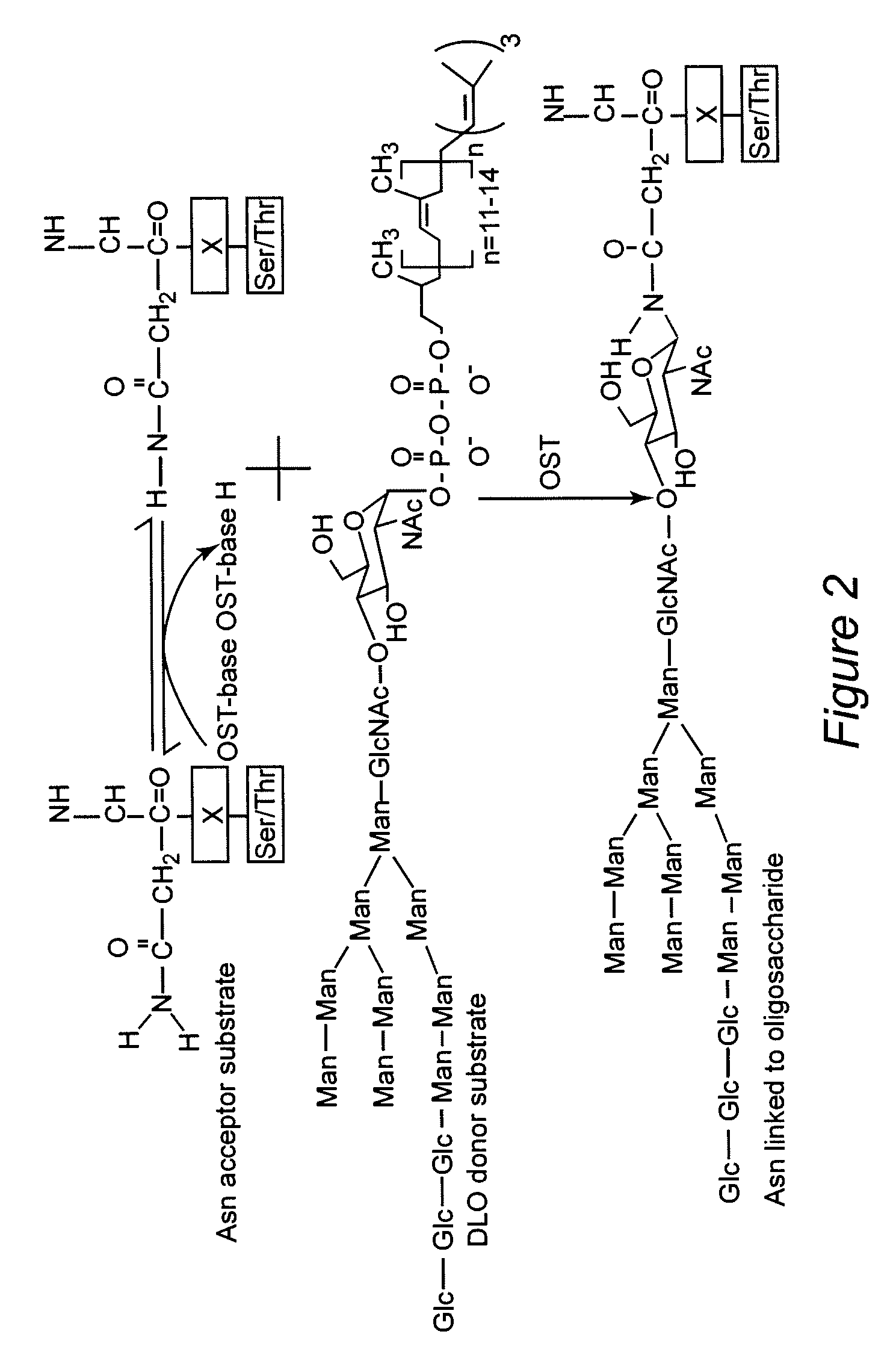Protein N-glycosylation of eukaryotic cells using dolichol-linked oligosaccharide synthesis pathway, other N-gylosylation-increasing methods, and engineered hosts expressing products with increased N-glycosylation
- Summary
- Abstract
- Description
- Claims
- Application Information
AI Technical Summary
Benefits of technology
Problems solved by technology
Method used
Image
Examples
example 1
Improving Production of Dolichol-Linked Oligosaccharide (DLO)
[0035] The inventors have recognized that the problem of glycosylation deficiency in biotechnology may be solved by improving production of DLO.
[0036] The present inventors designed an approach of studying the DLO metabolic pathway to identify possible limiting step(s), followed by overexpressing a putative enzyme(s) to overcome the DLO limitation and N-glycosylation deficiency in mammalian cell lines. In this Example, strategies are implemented to overcome N-glycosylation bottlenecks to improve N-glycan site occupancy for recombinant proteins expressed in commercially relevant mammalian and other eukaryotic cell lines.
[0037] No previous instance of the N-glycosylation being engineered in mammalian cells is known.
[0038] Combinations of Lipid-Linked Oligosaccharide Pathway Genes and Product Characterization.
[0039] Many genes are thought to be involved in the regulation of the dolichol-linked oligosaccharide pathway. Re...
example 1a
[0042] Polyprenols and dolichols are ubiquitous long-chain isoprenoid lipids found in all cells. (T. Chojnacki, G. Dallner, The biological role of dolichol, Biochem J 251 (1988), 1-9; S. S. Krag, The importance of being dolichol, Biochem Biophys Res Commun 243 (1998), 1-5.) A phosphorylated form, dolichyl phosphate (Dol-P), serves as a glycosyl carrier in eukaryotic cells during O- and C-mannosylation, N-linked glycosylation, and glycosylphosphatidyl inositol (GPI) transfer to proteins in the ER.
[0043] (P. Burda, M. Aebi, The dolichol pathway of N-linked glycosylation, Biochim Biophys Acta 1426 (1999), 239-257; J. Helenius, M. Aebi, Transmembrane movement of dolichol linked carbohydrates during N-glycoprotein biosynthesis in the endoplasmic reticulum, Semin Cell Devel Biol 13 (2002), 171-178; B. Schenk, J. S. Rush, C. J. Waechter, M. Aebi, An alternative cis-isoprenyltransferase activity in yeast that produces polyisoprenols with chain lengths similar to mammalian dolichols, Glycob...
example 1b
[0065] The approach of Examples 1 and 1A are applicable to any type of mammalian cell that generates N-glycans.
[0066] The genes of Examples 1 and 1A also can be incorporated into many different eukaryotic hosts including insect cells, yeast, and fungi in order to improve glycosylation in those hosts. The hCPT genes also may be incorporated into bacterial hosts in order to obtain glycosylation in those species or alternatively onto a microdevice to obtain glycosylation in vitro.
[0067] The approaches set forth in Examples 1 and 1A also may be used for making N-glycans themselves, for engineering tissues as well from eukaryotes in addition to cell lines, for treating diseases resulting from N-glycosylation deficiency (including but not limited to congenital disorders of glycosylation (CDG), alcoholism), and certain diseases relating to protein folding and glysolyation (such as Prion disorders), etc.
PUM
| Property | Measurement | Unit |
|---|---|---|
| Length | aaaaa | aaaaa |
| Length | aaaaa | aaaaa |
Abstract
Description
Claims
Application Information
 Login to View More
Login to View More - R&D
- Intellectual Property
- Life Sciences
- Materials
- Tech Scout
- Unparalleled Data Quality
- Higher Quality Content
- 60% Fewer Hallucinations
Browse by: Latest US Patents, China's latest patents, Technical Efficacy Thesaurus, Application Domain, Technology Topic, Popular Technical Reports.
© 2025 PatSnap. All rights reserved.Legal|Privacy policy|Modern Slavery Act Transparency Statement|Sitemap|About US| Contact US: help@patsnap.com



